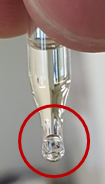Occasionally things go awry with our analyses. This post addresses troubleshooting for common problems with amino acid analysis.
Last time we talked about easy, preventative steps you can take to keep things running smoothly with AdvanceBio Amino Acid Analysis. But what about the occasional problem that pops up?
Let’s begin with poor resolution. What should we check?
- Many amino acid samples, including cell culture media, don’t require sample preparation. However, amino acid concentrations have to be appropriate for the detector response. If peaks are really broad leading to poor resolution, check if a more dilute sample gives a more appropriate response and better resolution.
- Use the low-volume heat exchanger in the column compartment, along with short, red tubing (0.12 mm i.d.) to minimize extra column volume.
- Double check your connections and fittings, especially if you notice the problem shortly after connecting a new column or replacing capillaries. Incorrect column connections can manifest as poor resolution. Agilent InfinityLab Quick Connect fittings are an easy solution to be sure you have good connections every time.
- Finally, it could be time to replace the column. Hopefully you’ve been tracking a couple of specs to see this one coming.
What about a low intensity chromatogram?
- The OPA or FMOC reagent may have deteriorated. Grab a new aliquot.
- Is there an air bubble in any of the vial inserts? It sounds so silly, but it happens! Especially if the FMOC-labeled amino acids look ok but the OPA-labeled amino acids give low response, or vice versa, an air bubble in a reagent vial insert is a plausible candidate. Simply tap the side of the insert to get rid of it.
These troubleshooting tips are mostly specific to implementing this amino acid analysis method. If the problem persists, it’s likely time to move on to troubleshooting the LC or the sample itself.
In our next installment on amino acid analysis, we’ll talk about how to save yourself a bit of time. Talk soon!
-Anne
Keywords: Bio columns, liquid chromatography, best practices, tips and tricks, troubleshooting, amino acids, AdvanceBio blog

